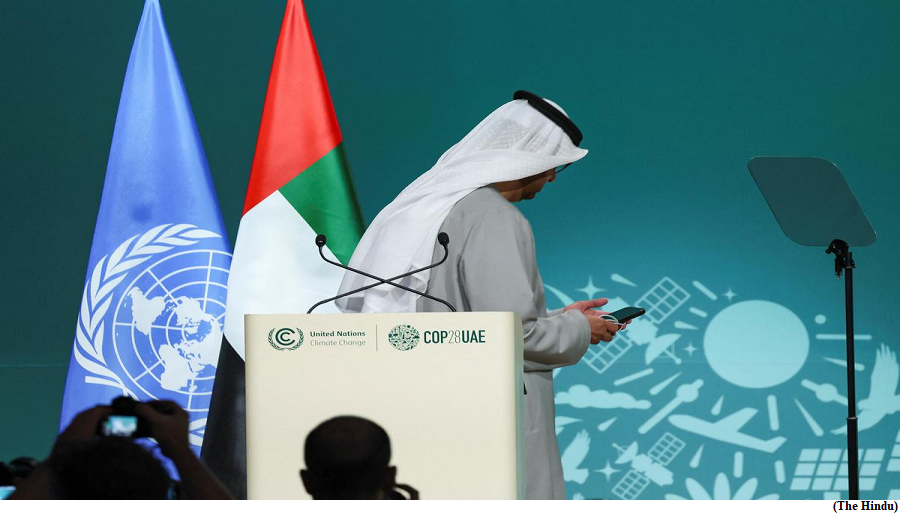Global Goal on Adaptation and the road from Dubai (GS Paper 3, Environment)

Context:
- The 28th meeting of the Conference of the Parties (COP) to the United Nations Framework Convention on Climate Change (UNFCCC), in Dubai, was notable in terms of stopping the careless approach of the international community to the adaptation concern.
Global Goal on Adaptation (GGA):
- Guided by the Paris Agreement on Global Goal on Adaptation (GGA), the efforts put in at COP26 and COP27 were what culminated in the adoption of the framework for GGA at COP28.
- The material progress on the implementation of the GGA requires that future climate change negotiations should show more urgency in treating adaptation on a par with mitigation as the world is witnessing extreme weather events, with devastating consequences.
- These climate change events are happening at only 1.1° Celsius as compared to pre-industrial levels.
- The best mitigation efforts enshrined in the nationally determined contributions (NDCs) of the Parties to the Paris Agreement are not in sight of restricting global average temperature below 1.5° C as compared to pre-industrial levels.
- They would rather nudge the world towards the 2.8° C point by the end of the century.
Challenges in GGA implementation:
- The framework of the GGA is expected to influence what type of adaptation action will be prioritised.
- A main target in the GGA includes the Parties to the Paris Agreement having “conducted up-to-date assessments of climate hazards, climate change impacts and exposure to risks and vulnerabilities and have used the outcomes of these assessments to inform their formulation of national adaptation plans, policy instruments, and planning processes and/or strategies”, by 2030.
- By 2027, all the Parties have to establish multi-hazard early warning systems, climate information services for risk reduction and systematic observation to support improved climate-related data, information and services. A significant point remains to be answered whether it will advance adaptation.
- A comprehensive review of experiences from the Millennium Development Goals found that globally agreed goals do not trickle down easily from the global to the national level.
- National conditions, including administrative capacity and economic development, were identified alongside adequate support as key influencing factors for the implementation of a global goal.
Measuring GGA:
- The Parties are expected to have progressed in their implementation of national adaptation plans, policies and strategies by 2030.
- Unlike mitigation of greenhouse gases, climate adaptation does not have a universal metric, and its ambition or implementation level cannot be simply aggregated based on countries’ national pledges.
- The GGA framework has taken an important decision to launch a two-year work programme on indicators for measuring progress achieved towards the targets. But it does not currently mention who will develop them, or how.
Potential role of universal indicators:
- In a global context of scarce public funds and competing priorities, the idea of spending in those adaptation activities would not pose much difficulty if their results can be fairly measured and compared. The idea of developing a standardised metric is one that is being supported by international donors and the national budget managers, which would help them in applying this to all sorts of adaptation projects.
- This kind of thinking is bolstered by the fact that the most sought-after dimension of climate change problem mitigation is working with one relatively simple and universal metric of CO2 equivalents, which can be applied across specific contexts to measure impacts in an easily comparable format.
Adaptation finance:
- The COP28 Draft Decision notes with concern that the adaptation finance gap is widening, which amounts to highlighting the widening gap between the estimated costs of meeting a given adaptation target and the amount of finance available.
- The COP26’s urge to developed countries to double overall adaptation finance from 2019 levels by 2025 was repeated in the Draft Decision. Estimation made on the basis of updated NDCs or national adaptation plans indicate a figure of $71 billion per year from now to 2030.
- The Organisation for Economic Co-operation and Development countries have already admitted that their combined mitigation and adaptation finance flows fell short of the annual $100 billion to $83.3 billion in 2020.
Climate financing and mitigation bias:
- There is also a strong bias in climate financing in favour of mitigation as compared to adaptation.
- The climate change regime has been largely mitigation centric; rich countries do not gain much as the benefits of adaptation are local, and mitigation projects generate benefits globally and the availability of low-cost mitigation options in developing countries.
- Buchner, in a study, said that the split between mitigation and adaptation finance is 95:5 (Climate Policy Initiative, Venice, 2011).
- Self-reporting made by finance providers indicates there has been a trend of increasing international adaptation finance to developing countries in recent years, reaching $28.6 billion in 2020, but the share of adaptation in total climate finance to developing countries was 34% in 2020, still far behind mitigation finance (Adaptation Gap Report, 2022).
Way Forward:
- The GGA is an encouraging development as it contains a number of developments that are very useful for the cause of adaptation.
- But it still falls woefully short in terms of treating adaptation on a par with mitigation as it lays stress on holding the increase in the global average temperature well below 2° C and 1.5° C essential for ensuring the continued availability of the largest number of adaptation options, and also adds greater levels of mitigation that will reduce the need for additional adaptation efforts.


